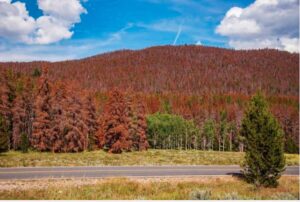A new report from the U.S. Department of Agriculture (USDA) finds American forests may convert from being carbon absorbers to significant carbon emitters. Researchers say the shift is due to the increasing destruction from natural disasters and the aging of forests, which is reducing their carbon-absorbing capabilities.
Our forests currently absorb 11 percent of U.S carbon emissions, or 150 million metric tons of carbon a year, equivalent to the combined emissions from 40 coal power plants.
However, starting in 2025, their ability to hold carbon may start plummeting and could emit up to 100 million metric tons of carbon a year as their emissions from decaying trees exceed their carbon absorption. Without action, forests could become a “substantial carbon source” by 2070, the USDA report says.
Already, several states in the Western U.S. have incrementally emitted more carbon than they removed from the atmosphere each year, including those in Colorado, Idaho, Montana, New Mexico, Utah, Arizona, Nevada, South Dakota and Wyoming – states with large amounts of federally-owned forests.
 Untreated insect epidemics and disease are resulting in significant tree mortality, which directly contributes to massive carbon-emitting wildfires. In Colorado, for example, the mountain pine beetle killed trees across 3.4 million acres between 1996 and 2013 (photo, right). Between 2011 and 2020, Colorado faced an average 5,618 wildfires each year that burned more than 237,000 acres annually.
Untreated insect epidemics and disease are resulting in significant tree mortality, which directly contributes to massive carbon-emitting wildfires. In Colorado, for example, the mountain pine beetle killed trees across 3.4 million acres between 1996 and 2013 (photo, right). Between 2011 and 2020, Colorado faced an average 5,618 wildfires each year that burned more than 237,000 acres annually.
The report also found that our forests are rapidly aging. Older, mature trees absorb less carbon than younger trees of the same species. Comparing forest management to prescribing the proper drugs to a patient, one researcher says one solution is cutting a small portion of aging forests to make ways for younger trees that absorb more carbon.
The best solution for reducing carbon emissions is to maintain the cycle of forestry- the continuous planting, growing and harvesting- that results in net zero carbon emissions and discourages the conversion of forests to non-forests. Yet federal agencies continue to fall behind, despite billions of dollars in new government spending on hazardous fuels reduction and other management efforts.
According to a May 2023 Congressional Research Service (CRS) report on National Forests System (NFS) lands, “Hazardous fuels can significantly affect wildfire behavior, and contribute to wildfires becoming more intense, severe, and difficult to contain.” The CRS notes that 63 million acres of NFS lands were at high or very high wildfire hazard potential in Fiscal Year 2022, yet “In the same year, the [Forest Service] reports the agency completed hazardous fuel treatments on 3.2 million acres on NFS and adjacent lands.”
This is a decrease from the 3.7 million acres reported treated in Fiscal Year 2021. According to CRS, “At this pace, it would take nearly 20 years to eliminate the backlog of treatment needs, not accounting for maintaining treated acres to the desired resource conditions. In addition, some estimate that hazardous fuels are accumulating three times faster than the rate of treatment.” [emphasis added]
This means at least 63 million acres of the National Forest System represent a significant carbon emissions liability to the American public and U.S. government. If, or when, these millions of acres of forests burn and die, hundreds of millions of tons of carbon will be released into the atmosphere. The Forest Service should do everything in its power to avoid this carbon emissions ticking time bomb.
It’s another reason why the Forest Service must substantially increase the pace and scale of forest management treatments to reduce fuel loads contributing to catastrophic wildfires, disease and insect infestation, and other mass forest mortality events that are emitting carbon and exacerbating climate change.



